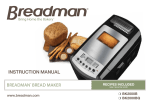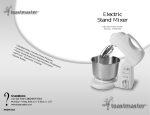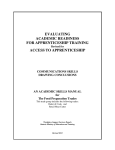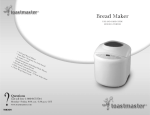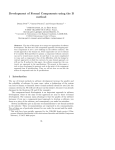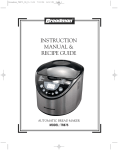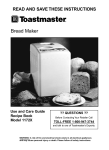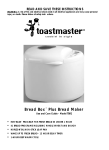Download Beko BKK 2505 User manual
Transcript
BKK 2505 BreadMaker User Manual Read this manual prior to initial operation of the product! Dear Customer, We hope that your product, which has been manufactured in modern facilities and passed through a strict quality control procedure, will give you very good results. We advise you to read through this manual carefully before using your product and keep it for future reference. The User Manual will help you use your machine in a fast and safe way. • Read the User Manual before installing and starting your product. • In particular, follow the instructions related to safety. • Keep this User Manual within easy reach for future reference. • Also read all additional documents supplied with this product. Remember that this User Manual is also applicable for several other models. Differences between models will be identified in the manual. Explanation of symbols Throughout this User Manual the following symbols are used: C Important information or useful hints about usage. A Warning for hazardous situations with regard to life and property. B Warning for supply voltage. TABLE OF CONTENTS This product has been produced in environmentally friendly, modern facilities CONTENTS 1 Safety Warnings 4 2 Technical Specifications of Your Appliance 5 3 Using the Appliance 6 Program selection Program descriptions Start / Stop Baking Selection Size of Loaf Keeping Warm Memory Ambient Conditions Warning Display First Use How To Make Bread Specific Information 6 6 7 7 7 7 7 7 7 7 8 9 4 Important Tips for Baking Tasty Bread About Bread Ingredients 9 10 Useful Tips / Recommendations 11 Bread Recipes 12 5 Cleaning and Care 14 6 Troubleshooting 15 3 EN 1 Safety Warnings The following safety warnings must be observed when using electrical appliances. 1. Please read all instructions thoroughly. 14. Never hit the edge of the chamber in order to remove the bread; otherwise, the chamber may be damaged. 2. Before use, check that the local voltage corresponds to the voltage indicated on the rating plate. 15. Due to the risk of fire or short circuit, avoid putting metal foils or similar materials in the breadmaker. 3. Never use the appliance when; the power cable or plug is damaged, dropped or exposed to any other damage. Take the appliance to the nearest authorized service for inspection and repair. 16. Never cover breadmaker with towels or cloths; heat and steam should freely exit the appliance. Covering the appliance with a flammable material or contacting with such materials may cause a fire. 4. Never touch hot surfaces. Use the grips and handles. 17. Use the appliance only its intended use. 5. Never immerse the cable, plugs or sockets of the appliance in water or any other liquid to avoid risk of electric shock. 19. Keep these instructions for further reference. 18. Do not use the appliance outdoors. 6. Disconnect the plug when the appliance is not in use, when mounting or dismounting the parts and before cleaning. 20. This appliance is only for household use, and is not recommended for commercial use. 7. Do not allow the cable to hang from the edge of the table or to make contact with hot surfaces. 21. If a power fails does not last more than 15 minutes when the product is in use, the program will resume. 8. Using accessories not recommended by the manufacturer may cause injury. 22. If you press the 'stop' button when the product is in use or a power failure continues for more than 15 minutes, the program will not resume. 9. This appliance is not intended for use by persons (including children) with reduced physical, sensory, or mental capabilities, or lack of experience and knowledge, unless they are supervised or instruct on the use of the appliance by a person responsible for their safety. 10. Never leave your breadmaker unattended when using it in the proximity of children. Never let children use the breadmaker without supervision. 11. Never place the appliance on hot gas stoves or electrical stoves, next to them or inside heated ovens. 23.If you are using a commercially sold ready bread mix in the machine, please use your breadmaker's standard program with the recipes provided on the mixture's package rather than the recipes provided in this user manual. Do not add salt, sugar, oil or yeast other than provided in the package of the ready bread mix. 24.Unless necessary, do not open the lid of the breadmaker, otherwise the bread will not rise sufficiently. The machine continues to operate even if the lid is opened. 12. Never touch moving or rotating parts when the machine is cooking. 13. Never turn on the appliance before placing the chamber securely in place when it contains dough. 4 EN 2 Technical Specifications of Your Appliance 4 5 1 2 7 6 3 9 8 10 1- Kneading paddle Voltage: 230 V~50 Hz 2- Chamber 3- Body Power: 600 W Insulation class: 1 4- Lid 5- Product's carrying handle 6- On/Off switch 7- Measuring cup 8- Large measuring spoon 9- Small measuring spoon 10- Kneading paddle removal hook Markings on the product or the values stated in other documents supplied with the product are values obtained under laboratory conditions as per relevant standards. These values may vary according to the use of the product and ambient conditions. 5 EN 3 Using the Appliance Function Description Shows the selection of bread size. Shows baking selection. (Less / Moderate / More) (Small 1 / Large 2) Shows the selected program. Shows operating time for each program. As soon as you connect the breadmaker's plug into the wall socket and press the on/ off button, you will hear a beep sound and "3:00" will soon be shown on the display. However, the colon (:) between 3 and 00 will not continuously flash. The arrow “ ” symbol on the panel will be on the II position. This is the default setting. Note: Small bread “I” setting represents a loaf of bread weighing (~750g) whereas Large bread “II” setting means a loaf of bread weighing (~900g). Program selection It is used to set different programs. Every time you press this button, the program changes along with a short beep. When continuously pressing the button, 12 menus will be shown on the LCD display sequentially. Select the program that you want. The 12 menu functions are described below. Program descriptions 1. Standard: Kneading, rising and baking normal bread. Also, you may add various ingredients to give added flavour. If you wish to use ready-made bread mixes sold in grocery stores, you should use this program in all circumstances. 2. Village bread: Kneading, rising and longer baking. This menu bakes the bread with a crisper crust and lighter texture. 6 3. Whole wheat bread: Kneading, rising and baking with whole wheat flour. This setting provides a longer preheating time to help the grain soak in water. Delaying function is not recommended to avoid unintended results. 4. Quick: This function does not allow the selection of loaf size. Kneading, rising and baking normal bread with baking soda as described in the recipe. This setting generally bakes the bread with a thicker texture and smaller size compared to normal programs. 5. Wholemeal bread: Kneading, rising and baking wholemeal bread. Intended to bake wholemeal bread. 6. Ultra quick-I :Small (I) Kneading, rising and baking normal bread in the quickest time. This setting bakes smaller and thicker loaves of bread compared to Quick program. 7. Ultra quick-II: With the same features above, it is intended for Large (II) bread. 8. Preparing Dough: It kneads and rises dough, but does not bake. Remove the dough to shape loaves of bread, pizza and etc. 9. Preparing Jam: Intended to boil jam and marmalade. 10. Baking Cake: Kneading, rising and baking the cake mixes with baking soda. 11. Bread Rolls: Kneading, rising and baking bread rolls. It is intended to bake bread rolls in a lighter texture and with a thinner crust. EN 12. Baking: No kneading or rising, only baking. power failure continues for longer than 15 minutes, the memory cannot be maintained and you will need to start the breadmaker again. However, if the dough has not passed the stage of rising when the power failure occurs, you should directly press "Start/Stop" button to start the program. Start / Stop Starts and stops the selected program. Press “Start/Stop” button once to start a program. You will hear a short beep and when the colon (:) on the timer begins flashing, this means that the program has started. After starting a program, all buttons become inactive except for the “Start/ Stop” button. Press and hold the “Start/Stop” button for approximately 3 seconds to stop the program. A long beep confirms that the program has turned off. This feature ends the program. Ambient Conditions The breadmaker can operate within a wide range of temperature, but the size of loaf may vary when the room is too warm or too cold. We recommend storing bread ingredients at room temperature, between 20°C and 34°C. Baking Selection Warning Display This button allows the user to select cooking the crust LESS, MODERATE or MORE. Press this button to select the crust colour of your choice. On the LCD display, the " ” arrow will turn to the colour that was selected. 1. If the display shows “H:HH” after starting the program (see Figure 1 below), it indicates that temperature in the chamber is still too high. In this case, you should end the program. Open the lid and let the machine to cool down for 10 to 20 minutes. 2. If the display shows “E:EE” after pressing the Start/Stop button, this indicates that the temperature sensor is disconnected, please have an Authorized Service Centre check the sensor. Size of Loaf Press this button to select the size of bread loaf. On the LCD display, you will see that the arrow will move to the positions of Small I and Large II. Total time of running will vary according to different loaf sizes. Keeping Warm The appliance may keep the bread warm for 60 minutes after baking is complete. If you want to remove the bread in the keep warm stage, press and hold the Start/ Stop button for 3 seconds to turn off the program. AZ ORTA ÇOK Figure 1 AZ ORTA ÇOK Figure 2 First Use IMPORTANT NOTE: AFTER REMOVING THE BREAD AT THE END OF THE PROGRAM, PRESS AND HOLD START/ STOP BUTTON FOR 3 SECONDS TO STOP THE APPLIANCE AND TURN OFF THE PRODUCT VIA ON/OFF BUTTON ON THE BACK. 1. Please make sure that all parts and accessories are complete and free from damage. 2. Clean all parts in accordance with the section "Cleaning and Care". 3. Switch the breadmaker to baking mode and perform baking for 10 minutes with the empty chamber. It is normal for the machine to emit some smoke. Clean the breadmaker again after it cools. 4. Completely dry all parts before replacing them; the appliance is now ready for use. Memory If a power failure occurs during the baking process; even if you don't press on the Start/Stop button, the baking automatically resumes if less than 15 minutes. If the 7 EN How To Make Bread 1. Put the bread chamber in place and turn clockwise until you hear a click to indicate that it is fixed in to position. Place the kneading paddle on the pivot pin. Apply a small amount of oil on the pin to facilitate removal of paddle after the kneading process is complete. 2. Place ingredients into the bread chamber. Please observe the order of the recipe. You should place liquid ingredients first, then add sugar, salt and flour. The yeast and baking soda, if required, should be added last. Note: Please check the recipe for maximum amounts of flour and yeast. 3. Create a small hollow in the middle of the flour using your finger. Put the dry yeast in this hole and ensure that the yeast does not make contact with liquids and salt. 4. Slowly close the lid and plug the appliance into the socket. 5. Press and hold the Program selection button until your choice is selected. The number and time of the selected program will be shown on the display. 6. Press and hold the Baking Selection button until your choice of crust preference is selected. 7. Press the Bread Size button to select small I or large II for the size of your bread. 8. If you would like to postpone the baking process, press the buttons Time + or Time – to adjust the time. Press the button time+ or time- to select the hour when you want the bread to be ready. Prepare the appliance for baking and press the Start / Stop button. For instance, if it is 20:00 now, and you want the bread to be ready at 8 o'clock in the morning; then you need to adjust program time to 12 hours. This appliance allows the user to set the time for up to 13 hours. You may skip this step if you would like the breadmaker to start immediately. 9. Press the Start/Stop button to start the operation. 10.You will hear a beep when operating 8 programs Normal, Village Bread, Whole Wheat Bread, Wholemeal Bread and Bread Rolls. This reminds you to add ingredients such as olives, walnuts, raisins and cereals. Open the lid and quickly add the ingredients according to the recipe. The lid should be kept open as shortly as possible during baking. 11.10 beeps will be heard when baking ends. Press and hold Start/Stop button for 3-5 seconds to end the process and remove the bread. Open the lid and grab the bread chamber's handle firmly with oven gloves. By turning the chamber anti-clockwise, lift it upwards slowly and remove it from the machine. 12.To release the bread from the sides of the chamber, lightly loosen the sides with a nonstick spatula. It will be easier to remove the bread. Warning: The chamber and bread may be extremely hot! Hold them with oven gloves very carefully. 13.Turn the bread chamber upside down and shake lightly until the bread release. 14.Remove the bread carefully from the chamber and allow it cool down for about 20 minutes before slicing. 15.If you are not in the room when baking ends, and you have not pressed the Start/stop button, the bread will automatically be kept warm for 1 hour and the warming process will end. 16. Turn off and unplug the appliance when not in use or not fully operating. Note: Before slicing the bread, use the hook to remove the kneading paddle which might be in the bread. You can easily remove the paddle by inserting the hook beneath the bread. The bread is hot; never remove the kneading paddle with bare hands. EN Specific Information 1. To make bread quickly Baking soda, activated with moisture and heat, is used when you need to get the bread ready quickly. The Quick program is intended only for baking normal white bread in the amounts prescribed, in under 1 hour and 40 minutes. Important Warnings for Quick Programs 1. For all quick programs, the water temperature should be 45-50 ºC. 2. We recommend not to use quick programs unless it is necessary. As the leavening time is shorter in quick programs, the inner texture of the bread will be thick and rising will be less comparable to normal programs. 3. In quick programs, baking soda should be used in the prescribed amounts in addition to Instant dry yeast. 2. About the ultra quick program The appliance can bake bread within about 1 hour thanks to the ultra quick program. The ultra quick I program makes Small (I) bread and ultra quick II program makes Large (II) bread, and they are intended for normal white bread only. 4 Important Tips for Baking Tasty Bread One important step of baking good bread is to use ingredients in the correct proportions. Unless otherwise indicated, all ingredients should be at room temperature. Only water and milk can be used lukewarm (20-25º C). It is strongly recommended to use kitchen scales, measuring cups or measuring spoons to accurately determine amounts; otherwise, the bread quality will be effected. 1. Measuring liquid ingredients: Water, fresh milk, or oil should be measured with a measuring cup. Visually check the horizontal level of the measuring cup. For baking bread, Instant dry yeast powder must be used. 2. Measuring solid ingredients: Flour, salt, sugar and Instant dry yeast powder can be measured by using a measuring cup or measuring spoon. Remaining materials should be stored in air-tight containers. 3. If you would like to use commercially sold 1-loaf bread mixes and Instant dry yeast powder, please apply the breadmaker recipes described on the mix's package and select the standard program of the breadmaker. 9 4. All ingredients should be appropriate for use (using potable water, using fresh dry ingredients such as flour, yeast, salt and sugar). 5. The lid should not be opened unless necessary. The breadmaker keeps operating even if the lid is open. 6. You should follow the order of adding ingredients into the chamber. The order should be: liquid ingredients, eggs, salt, sugar, flour and yeast. The yeast should not come in contact with water or salt. After kneading the dough for a while, a beep indicates the time to add olives, cereals etc. in prescribed amounts. If those food items are added too early, their taste is lost due to excess kneading. When you use the delay function for an extended time, avoid adding eggs or fruit as they can turn bad. EN About Bread Ingredients Bread flour Bread flour is rich in gluten content (that is why it is also known as gluten flour with high level of protein), it has a good elasticity and prevents deformation of the bread after rising. As its gluten content is higher than normal flour, it can be used for making larger bread and a thicker inner texture. The most important ingredient of bread is bread flour. 1. Regular flour: Regular flour is prepared by mixing well selected soft and hard grains and used for baking bread and cake quickly. 2. Whole wheat flour: Whole wheat flour is prepared by milling whole wheat, it contains wheat husks; the gluten of whole wheat flour is richer and is more nutritious than regular flour. Bread made of whole wheat flour is generally smaller. Thus, many recipes recommend using whole wheat and regular flour together for obtaining the best results. 3. Brown wheat flour: Also known as "Coarse flour", brown wheat flour contains high fiber and resembles wholemeal flour. To obtain larger loaves after rising, it should be used in combination with bread flour in high proportions. 4. Cake flour: Cake flour is prepared by milling soft wheat or low-protein wheat and is used especially in the cakes. Various flour types have similar appearance; actually, the yeast's performance or water absorption capacity of various types of flour vary according to the region of origin, growing conditions, milling process, and storage life of the flour. You may test different brands of flour sold in your local environment and compare their tastes in order to select one that offers the best flavour. 5. Corn flour and oatmeal: Corn flour and oatmeal are prepared by milling corn and oats, respectively. Both are additives used for baking coarse bread and to enrich the flavour and texture. 10 Sugar Sugar is a very important ingredient that increases flavour and colour of the bread. It leavens the bread and increases nutritional value; generally white sugar is used. Optionally, brown sugar, icing sugar or candy floss may be used. Instant dry yeast powder The yeast goes through a dough-like fermentation process; it generates carbon dioxide, makes the bread rise and provide a soft inner texture. However, leavening requires the carbohydrates in the sugar as well as from the flour for nourishment. As it will go bad in high temperatures, the yeast should be stored in the refrigerator; please check the date of production and shelf life of your yeast. Immediately after each use, return the yeast to the refrigerator in an air-tight container. Generally, bread does not rise because of stale yeast. You can check if your yeast is fresh and active by applying the following methods. (1) Pour 1/2 cup of lukewarm (4550°C) water into a measuring cup. (2) Add 1 teaspoon of white sugar into the cup, mix and sprinkle 2 teaspoons of yeast powder onto the water. (3) Leave the measuring cup for 10 minutes in a warm place. Do not stir the water. (4) The resulting foam should be approximately equal to 1 cup. Otherwise, the yeast is stale and won't work. Salt Salt is required to increase taste and the crust colour of the breads. The salt also limits the rising of yeast. Never use too much salt in your recipe; and if you don't want to use salt, skip this step. The bread will be larger without salt. Eggs Eggs improve the texture of the bread, and makes the bread more nutritious, increases the size, and gives a flavour EN to the bread, you may use one whisked egg in the village bread. Oil, butter and vegetable oil Oil makes the bread soft and extends storage life. After removing the butter from the refrigerator, you should melt it or cut it into small pieces to make it suitable for mixing. Baking soda Baking soda is used in quick bread programs. It does not require time for rising and generates air bubbles that soften the texture of the bread according to its chemical properties. Water and other liquid Water is a basic ingredient when baking bread. Generally, water temperature between 20°C and 25°C is best. However, in quick baking, the water temperature should be 45-50°C to obtain necessary rising speed. To increase the bread's taste and improve the crust colour, you can use a mixture of fresh milk and water instead of only water. In some recipes, apple juice, orange juice or lemon juice may be used to improve the taste of bread. All suggestions depends on personal preference. 5. 6. 7. 8. Useful Tips / Recommendations 1.Tips for measurements in the recipes; 1 Larger measuring spoon = 15 ml / tablespoon 1 Small measuring spoon = 5 ml / teaspoon 1 Measuring cup of flour = 150g 1 Measuring cup of liquid = 200 ml.(shown on the cup) 2. In all baking programs, you will hear a beep when the program ends. If the bread is going to be removed without delay, press and hold start/stop button for 3 seconds to stop the machine. Otherwise, the machine will keep running in the oven baking mode. 3. Avoid opening the breadmaker's lid if possible. and the yeast powder supplied in the package, you should apply the breadmaker recipe described on the mix's package and select the 3-hour standard program of the appliance whatever the type of bread mix used. As the ready bread mix contains salt, sugar etc., you should not add those ingredients. If you would like to make different kinds of bread: using standard program and the programs of village bread, wholemeal bread and bread rolls, you can optionally add 100g of olives (without seeds), walnuts, raisins or cereals into the dough by opening the lid when you hear the first beep. This adding process should be done as quickly as possible as we do not recommend opening the lid of the machine to ensure proper rising level of the bread. You are not able to select the bread size in the quick program; the machine automatically selects the normal size and normal white bread is baked using the prescribed amounts. In Ultra Quick and Quick programs, hot water (45-50 C) and 1 packet of (10g) baking soda should be used. Ultra Quick and Quick programs provide the advantage of time, however, the inner texture and rising of the bread will be less satisfying than the bread made in other regular programs. Thus, we recommend not to use quick programs unless necessary. 4. If you are going to use ready made bread mixes sold in grocery stores 11 EN Bread Recipes Normal White Bread Program Position Standard Baking position Bread size Water Less/Moderate/More Small ( I ) Large ( II ) 300 ml 320 ml Vegetable oil 1 Large measuring spoon 1 ½ Large measuring spoon Milk 1 Large measuring spoon 1 ½ Large measuring spoon White Flour 3 Measuring Cups (450g) 3 and 1/3 Measuring cups (500g) Sugar 2 Small measuring spoons 3 Small measuring spoons Salt 1 ½ Small measuring spoons 1 ½ Small measuring spoons Instant dry yeast powder 1 ½ Small measuring spoons 1 ½ Small measuring spoons Village Bread Program Position Village Bread Baking position Bread size Water Vegetable oil White Flour Less/Moderate/More Small ( I ) Large ( II ) 280 ml 300 ml 1 Large measuring spoon 1 ½ Large measuring spoon 3 full measuring cups (450g) 3 and 1/3 Measuring cups (500g) Milk 1 Large measuring spoon 1 ½ Large measuring spoon Sugar 2 Small measuring spoons 2 Small measuring spoons Salt 1 Small measuring spoons 1 ½ Small measuring spoons 1 ½ Small measuring spoons 1 ½ Small measuring spoons Instant dry yeast powder Whole Wheat Bread Program Position Whole Wheat Bread Baking position Less/Moderate/More Bread Size Water Small ( I ) Large ( II ) 260 ml 280 ml 2 1/3 measuring cups (300g) 3 full measuring cups (400g) 1 measuring cup (150g) 2/3 measuring cup (100g) Vegetable oil 1 Large measuring spoon 1 ½ Large measuring spoons Sugar 2 Small measuring spoons 3 Small measuring spoons 1 ½ Small measuring spoons 1 ½ Small measuring spoons 2 Small measuring spoons 2 ½ Small measuring spoons Whole Wheat flour White Flour Salt Instant dry yeast powder 12 EN Quick White Bread Program Position Quick Baking position Less/Moderate/More Bread size ------(selection not allowed) Hot Water ( 45-50 C) 280 ml Vegetable oil 1 Larger measuring spoon Milk 1 Larger measuring spoon White Flour 3 Measuring Cups (450g) Sugar 2 Small measuring spoons Salt 1 ½ Small measuring spoons Baking soda 1 packet (10g) Instant dry yeast powder 1 ½ Small measuring spoons Wholemeal Bread Program Position Wholemeal Bread Baking position Bread Size Water Less/Moderate/More Small ( I ) Large ( II ) 290 ml 300 ml Vegetable oil 1 Large measuring spoon 1 ½ Large measuring spoon Wholemeal flour (pure) 2/3 measuring cup (90g) 1 measuring cup (120g) 2 1/3 measuring cups (360g) 2 4/3 Measuring cups (380g) White flour Sugar Salt Instant dry yeast powder 2 Small measuring spoons 3 Small measuring spoons 1 ½ Small measuring spoons 1 ½ Small measuring spoons 2 Small measuring spoons 2 ½ Small measuring spoons Ultra Quick-I Ultra Quick-II Ultra Quick White Bread Program Position Baking position Bread size Hot Water ( 45-50 C) Less/Moderate/More Small ( I ) (Auto selection) Larger ( II ) (Auto selection) 280 ml 300 ml Vegetable oil 1 Larger measuring spoon 1 ½ Larger measuring spoon Milk 1 Larger measuring spoon 1 ½ Larger measuring spoon White Flour 3 Measuring Cups (450g) 3 and 1/3 Measuring cups (500g) Sugar Salt Baking soda Instant dry yeast powder 2 Small measuring spoons 3 Small measuring spoons 1 ½ Small measuring spoons 1 ½ Small measuring spoons 1 packet (10g) 1 packet (10g) 1 ½ Small measuring spoons 2 Small measuring spoons 13 EN Bread Rolls Program Position Bread Rolls Baking position Less/Moderate/More Small ( I ) Large ( II ) 280 ml 300 ml Vegetable oil 1 Larger measuring spoon 1 ½ Larger measuring spoon Milk 1 Larger measuring spoon 1 ½ Larger measuring spoon White Flour 3 Measuring Cups (450g) 3 and 1/3 Measuring cups (500g) Salt 1 ½ Small measuring spoons 1 ½ Small measuring spoons Instant dry yeast powder 1 ½ Small measuring spoons 1 ½ Small measuring spoons Bread size Water Jam Recipes Program Position Jam Preparation Strawberry 500g Granulated sugar 500g Admixture for jam Half packet of jam admixture (Approximately 15g) Water 1/4 Measuring cup (50 ml) Sour Cherry 500g Granulated sugar 500g Admixture for jam Half packet of jam admixture (Approximately 15g) Water 1/2 Measuring cup (100 ml) Clean and dice strawberries or sour cherries finely and place them into the chamber. In another bowl, mix 3 large measuring spoons of granulated sugar and a 1/2 packet of jam admixture. Add sugar to the ingredients in the chamber and wait for 3 hours. Later, pour the mixture of sugar and jam admixture into the chamber, add 50ml water for strawberries and 100ml water for sour cherries. Select the program of jam preparation and start the appliance. Note: If the jam does not reach the intended texture at the end of the program, you can make the jam thicker by using the baking function. 5 Cleaning and Care Unplug the breadmaker and let it cool down before cleaning. 1. Chamber: Wipe inner and outer parts with a damp cloth. Never use sharp or abrasive objects to avoid damaging the nonstick coating. Dry the chamber thoroughly before mounting it in place. 2. Kneading paddle: When it is difficult to remove the kneading paddle from the pin, fill the chamber with hot water and wait for 30 minutes. Thus, the kneading paddle may be easily removed for cleaning. Clean the kneading paddle carefully with a damp cotton cloth. Clean dough from the pin thoroughly. 14 3. Lid and window: clean inside and outside of the lid with a damp cloth. 4. Clean the outer surface of the body softly with a damp cloth. Never use abrasive cleaning agents. Never immerse the appliance body in water to clean. 5. Before returning the breadmaker to its package for storage, make sure that it is cold enough, dry and clean and its lid is closed. 6. Never wash the chamber and kneading paddle in the dishwasher. EN 6 Troubleshooting No. Problem Reason Solution 1 Smoke comes out of the vent hole during cooking. Some materials can stick on the heating element or to the side of it or oil remains on the heating element during first use. Unplug the breadmaker and clean the heating element, but be careful not to burn your hands. 2 Lower crust of the bread is too thick Using the keep warm function or keeping the bread in the chamber for a long time causes large loss of moisture. In the warming function, remove the bread earlier 3 It is difficult to remove the bread Kneading paddle might be stuck on the pin. To release the sides of the bread from the chamber, carefully loosen the sides with a nonstick spatula softly. Fill the chamber with hot water after removing the bread, keep the kneading paddle soaking in water for 30 minutes, then remove and clean. Improper program selection Do not open the lid if possible. The bread has dried and the crust is not brown as the lid was opened several times during the operation. Do not open the lid at the final rising stage Kneading paddle cannot rotate and cannot blend ingredients properly if the mixing resistance is too high. Check the kneading hole, remove the bread chamber and mix without the load. If it is not normal again, contact the authorized service centre. 4 Ingredients do not mix well and poor baking results 5 The display shows “H HH” after pressing the "Start/ Stop” button. The temperature of the breadmaker is too high for baking bread. Press the "Start/Stop” button and unplug the bread maker. Then, remove the bread chamber and keep the lid open until the machine cools down. 6 Motor sound is heard, but kneading is not performed. The chamber or kneading paddle is not installed properly or the dough is too big for mixing. Check if the chamber is installed properly and the dough is prepared according to the recipe, also check if the ingredients were weighed accurately. 7 The size of bread is so large that is pushes the lid Excessive amounts of yeast, flour or water or ambient temperature is too high. Check the factors above and reduce amounts to intended levels. 8 The size of bread is too small or the bread is not rising. You haven't add yeast or it is not enough; also yeast does not function properly if the water temperature is too high, or the yeast mixes with salt, or the ambient temperature is low, Check the amount and performance of the yeast, raise to the intended ambient temperature. 9 The dough is so large that it overflows the chamber. There are excessive liquid ingredients softening the dough, or the amount of yeast is excessive. Reduce the amount of liquid ingredients and adjust the dough's hardness. The flour and baking soda is not strong enough to rise the dough Use bread flour or a strong baking soda. Leavening is too fast or the yeast temperature is too high. The yeast should be used at room temperature. Excessive amount of water softens the dough and dampens it excessively. Depending on the water's absorption, adjust the amount of water in the recipe. Too much flour or lack of water. Reduce the amount of flour or increase the water. Additives are excessive or the amount of whole wheat flour is excessive Reduce that ingredient's amount or increase the yeast. Excessive amount of water or yeast, or no salt used. Reduce the amount of water or yeast and check the salt. Water temperature is too high. Check water temperature. The bread contains sticky ingredients such as butter, banana etc. Do not add sticky ingredients in the bread. It is not blended properly due to lack of water. Check the amount of water and mechanical operation of the breadmaker. Various recipes and ingredients give different results; the large amount of sugar darkens the colour. If the colour is too dark due to use of excessive sugar, press the Start/Stop button to end the program 5-10 minutes earlier than the intended time. Before removing the bread, you need to keep the bread or cake in the chamber for 20 minutes with the lid closed. 10 The middle of the bread collapses when the dough is cooking. 11 The bread is too heavy and has a thick texture. 12 The interior of the bread has tunnels. 13 14 The bread's surface is dusty. The crust is too thick and the colour is too dark in cakes and sweet pastry. 15 EN www.beko.com
















